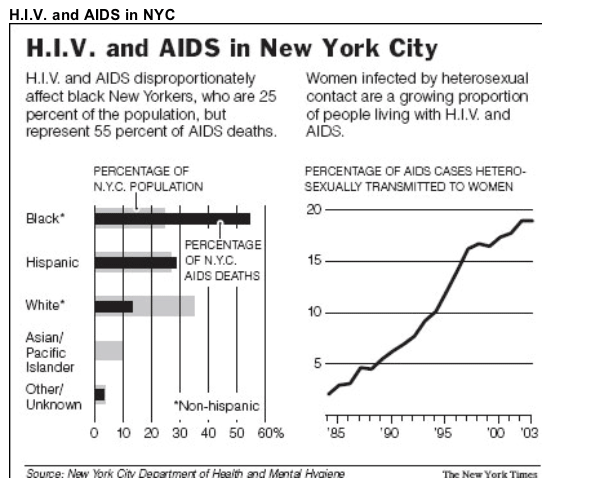| |
Report Highlights AIDS Risk to Black Men and Women
|
| |
| |
Black men die at a rate six times that of white men, and black women die at a rate nine times that of white women.
NY Times
By MARC SANTORA
Published: February 4, 2006
In the decade since effective drug treatments for AIDS have slashed death rates across the country, black New Yorkers continue to fall ill and die at startling rates, according to new data from the city health department.

Today, one in five black men in New York City between 40 and 49 has H.I.V. or AIDS. Black women, meanwhile, account for 34 percent of new AIDS cases, up from 12 percent 20 years ago.
Further, heterosexual sex has now replaced drug use as the most common means of transmission of the virus to women, creating a more difficult terrain for health care workers.
While there is a disparity in infection rates between whites and others across a spectrum of diseases, health officials are particularly struck by those among AIDS patients in New York. Although blacks make up only 25 percent of the city's population, they account for 50 percent of all AIDS fatalities.
Black men die at a rate six times that of white men, and black women die at a rate nine times that of white women.
Health officials who have been tracking the disproportionate AIDS death rates among minorities over the last several years say those rates stem from factors including a failure to identify the sick and get them into treatment, as well as a failure to keep them in care and the strong stigma that AIDS carries in many minority neighborhoods.
Last week, Dr. Thomas R. Frieden, the city's health commissioner, said that changing this grim portrait of AIDS would require a radical rethinking of how to combat the disease, including changes in state law to allow health workers to test people for H.I.V. more aggressively and permit health department workers to use the information the city already collects to reach out directly to patients and their doctors to help in treatment.
Mr. Frieden would like to have patients tested for H.I.V. as part of their routine medical care. While changes would still require oral consent, he would like to ease the cumbersome process of written consent and hearing from their doctors the downside of being tested, as the law currently requires.
The city has struggled for years to find ways to provide AIDS information to certain groups, like married men who secretly also have sex with other men.
Some health care experts say, however, that the city has been too slow to act.
"The city has buried its head in the sand on this as far as I am concerned," said Dr. Karen Brudney, director of the infectious diseases clinics at NewYork-Presbyterian/Columbia Hospital.
"For 10 years I have seen rising rates and rising caseloads," she said. While strongly supporting Dr. Frieden's efforts, she said the city needed to focus on problems that prevent patients from getting basic care, like frequent changes in residence.
There are few financial barriers to getting care for H.I.V. and AIDS, however. Through an elaborate network of programs financed by the city, the state and the federal government, help is available and drug treatments for even the poorest patients are fully subsidized.
But the latest statistics from the Health Department show that many people who most need care fail to get it.
When AIDS largely affected gay white men, those men tended to take charge of their own care, health officials said.
That has not happened among black and Latino men and women, in large part, health officials say, because many patients would rather die than risk having family or friends find out they are sick.
For instance, Chelsea, with a large population of gay white men, continues to have the highest rate of newly diagnosed cases in the city, 153 per 100,000 people in 2004. Central Harlem is close behind, with 119 newly diagnosed people for every 100,000.
Yet infected people in Chelsea are half as likely to die from the disease.
Black women have been particularly hard hit: Heterosexual sex accounts for an increasing rate of new AIDS cases.
The increase in H.I.V. infection among young women is even more alarming. In New York, girls and women now account for 48 percent of new infections among teenagers 13 to 19, according to a December report by the New York State AIDS Advisory Council.
The rate of AIDS among black women is 27 times the rate among white women.
The report found that a variety of reasons, including cultural and gender issues, come into play in the lives of minority and ethnic women. "Women are expected to accept, or at least not to question, the lifestyles of their male partners," the report stated.
Concerns about stigma and privacy originally led to stringent laws to protect patients. But those laws, however necessary 20 years ago, also meant that many of the traditional public health approaches used in fighting other infectious diseases - like contacting patients about their need for treatment - could not be used. The threat of violence also deters women from trying to negotiate safer sex or resisting unprotected sex, the report said. Secrecy and denial about high-risk activity, prostitution and infidelity pervade many ethnic groups, and as better drugs became available and death rates fell, many health experts said, a sense of complacency settled in.
|
|
| |
| |
|
|
|